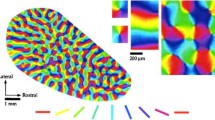Abstract
The mammalian visual cortex is comprised of “hypercolumns” of orientation selective cells. The developmental process by which cells are generated with receptive fields tuned to a variety of orientations has so far remained a mystery. We present a model for the production of orientation selective cells that requires no external stimuli and a minimum of input parameters. The process involves spontaneous symmetry-breaking in an energy function that governs the maturation of the cortical cells in a multi-layer network of Hebb-type feedforward neurons. An important feature is that the symmetry breaking occurs for each cell separately and is not due to global organizing effects. We present examples of receptive field profiles calculated with the symmetry-breaking procedure and note that the results seem robust and may be useful in the study of development in several types of cortical cells. The inclusion of long range lateral (intra-layer) correlations in the energy function could result in the development of cell groups with correlated preferred orientations that resemble the hypercolumns seen in the visual cortex.
Similar content being viewed by others
References
Abers ES, Lee BW (1973) Gauge theories. Phys Rep 9:1–141
Bienenstock EL, Cooper LN, Munro PW (1982) Theory for the development of neuron selectivity: orientation specificity and binocular interaction in visual cortex. J Neurosci 2:32–48
Braitenberg V, Braitenberg C (1979) Geometry of orientation columns in the visual cortex. Biol Cybern 33:179–186
Coleman S (1985) Aspects of symmetry. Cambridge University Press, Cambridge, pp 113–184
Cowan JD (1982) Spontaneous symmetry breaking in large scale nervous activity. Int J Quant Chem 22:1059–1082
Daugman JG (1985) Uncertainty relation for resolution in space, spatial frequency, and orientation optimized by two-dimensional visual cortical filters. J Opt Soc Am 2:1160–1169
Guth AH (1981) Inflationary universe: a possible solution to the horizon and flatness problem. Phys Rev D 23:347–356
Hirsch HVB, Spinelli DN (1971) Modification of the distribution of receptive field orientation in cats by selective visual exposure during development. Exp Brain Res 13:509–527
Hubel DH, Wiesel TN (1962) Receptive fields, binocular interaction, and functional architecture in the cat's visual cortex. J Physiol (London) 160:106–154
Hubel DH, Wiesel TN (1974) Sequence regularity and geometry of orientation columns in the monkey striate cortex. J Comp Neurol 37:267–294
Leventhal AG, Hirsch HVB (1977) Effects of early experience upon orientation selectivity and binocularity of neurons in visual cortex of cats. Proc Natl Acad Sci USA 74:1272–1276
Linsker R (1986a) From basic network principles to neural architecture: emergence of spatial-opponent cells. Proc Natl Acad Sci USA 83:7508–7512
Linsker R (1986b) From basic network principles to neural architecture: emergence of orientation-selective cells. Proc Natl Acad Sci USA 83:8390–8394
Linsker R (1986c) From basic network principles to neural architecture: emergence of orientation columns. Proc Natl Acad Sci USA 83:8779–8783
Malsburg C von der, Cowan JD (1982) Outline of a theory for the ontogenesis of iso-orientation domains in visual cortex. Biol Cybern 45:49–56
O'Kusky J, Colonnier M (1982) A laminar analysis of the number of neurons, glia, and synapses in the visual cortex (Area 17) of adult Macque monkeys. J Comp Neurol 210:278–290
Pearlmutter BA, Hinton GE (1986) G-maximization: an unsupervised learning procedure for discovering regularities. In: Denher JS (ed) Proceedings of the AIP Conference on Neural Networks for Computing
Rose D, Dobson VG (eds) (1985) Models of the visual cortex. Wiley, New York
Sattinger DH (1979) Group theoretic methods in bifurcation theory. Lecture Notes in Mathematics, vol 762. Springer, Berlin Heidelberg New York
Stent GS (1973) A physiological mechanism for Hebb's postulate of learning. Proc Natl Acad Sci USA 70:997–1001
Stewart I (1987) Bifurcations with symmetry. In: New directions in dynamical systems. Chaos Workshop, King's College, Cambridge (in press)
Stone M (1976) Lifetime and decay of “excited vacuum” states of a field theory associated with nonstable minima of its effective potential. Phys Rev D 14:3568–3573
Author information
Authors and Affiliations
Rights and permissions
About this article
Cite this article
Kammen, D.M., Yuille, A.L. Spontaneous symmetry-breaking energy functions and the emergence of orientation selective cortical cells. Biol. Cybern. 59, 23–31 (1988). https://doi.org/10.1007/BF00336887
Received:
Accepted:
Issue Date:
DOI: https://doi.org/10.1007/BF00336887




